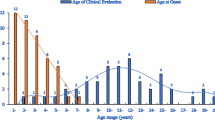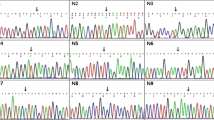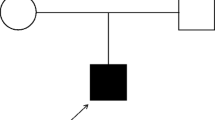Abstract
Duchenne muscular dystrophy (DMD) and Becker muscular dystrophy (BMD) are caused in the majority of cases by deletions of the DMD gene and are readily detectable in affected males by multiplex polymerase chain reaction (PCR). However, different approaches must be used for the identification of female carriers, in which deletions are not detectable by PCR, because of the presence of a normal X chromosome. In this study, we used the multiple ligation probe amplification (MLPA) tool for the identification of female carriers of DMD deletions or duplications in 12 families with a single affected male, 10 of which were previously diagnosed as carriers of a DMD rearrangement, and the remaining two as having an unknown disease-causing mutation. In all the investigated affected males, MLPA analysis confirmed the presence of a DMD rearrangement, and in six of them allowed the refinement of the breakpoints. In 12 female relatives of the affected patients, MLPA analysis showed a DMD deletion or duplication, confirming their carrier status. Two of these were the mother and the sister of a patient whose disease-causing mutation was not known. MLPA analysis thus proved to be an useful tool for the analysis of both affected males and females carriers of DMD rearrangements in cases in which the disease-causing mutation in the affected male was not known, providing useful information for the genetic counselling of the family.



Similar content being viewed by others
References
Abbs S, Bobrow M (1993) Report on the 16th ENMC Workshop—carrier diagnosis of Duchenne and Becker muscular dystrophy. Neuromuscul Disord 3:241–242
Beggs AH, Koenig M, Boyce FM, Kunkel LM (1990) Detection of 98% of DMD/BMD gene deletions by polymerase chain reaction. Hum Genet 86:45–48
Chamberlain JS, Gibbs RA, Ranier JE, Nguyen PN, Caskey CT (1988) Deletion screening of the Duchenne muscular dystrophy locus via multiplex DNA amplification. Nucleic Acids Res 16:11141–11156
Cinti C, Stuppia L, Maraldi NM (2002) Combined use of PRINS and FISH in the study of the dystrophin gene. Am J Med Genet 15:115–118
Clemens PR, Fenwick RG, Chamberlain JS, Gibbs RA, Andrade M de, Chakraborty R, Caskey CT (1991) Carrier detection and prenatal diagnosis in Duchenne and Becker muscular dystrophy families, using dinucleotide repeat polymorphisms. Am J Hum Genet 49:951–960
Darras BT, Harper JF, Francke U (1987) Prenatal diagnosis and detection of carriers with DNA probes in Duchenne’s muscular dystrophy. N Engl J Med 316:985–992
Den Dunnen JT, Grootscholten PM, Bakker E, Blonden LA, Ginjaar HB, Wapenaar MC, Paassen HM van, Broeckhoven C van, Pearson PL, Ommen GJ van (1989) Topography of the Duchenne muscular dystrophy (DMD) gene: FIGE and cDNA analysis of 194 cases reveals 115 deletions and 13 duplications. Am J Hum Genet 45:835–847
Erlandson A, Samuelsson L, Hagberg B, Kyllerman M, Vujic M, Wahlstrom J (2003) Multiplex ligation-dependent probe amplification (MLPA) detects large deletions in the MECP2 gene of Swedish Rett syndrome patients. Genet Test 7:329–332
Forrest SM, Cross GS, Flint T, Speer A, Robson KJ, Davies KE (1988) Further studies of gene deletions that cause Duchenne and Becker muscular dystrophies. Genomics 2:109–114
Fortina P, Cheng J, Shoffner MA, Surrey S, Hitchcock WM, Kricka LJ, Wilding P (1997) Diagnosis of Duchenne/Becker muscular dystrophy and quantitative identification of carrier status by use of entangled solution capillary electrophoresis. Clin Chem 43:745–751
Hogervorst FB, Nederlof PM, Gille JJ, McElgunn CJ, Grippeling M, Pruntel R, Regnerus R, Welsem T van, Spaendonk R van, Menko FH, Kluijt I, Dommering C, Verhoef S, Schouten JP, Veer LJ van’t, Pals G (2003) Large genomic deletions and duplications in the BRCA1 gene identified by a novel quantitative method. Cancer Res 63:1449–1453
Hu XY, Ray PN, Murphy EG, Thompson MW, Worton RG (1990) Duplicational mutation at the Duchenne muscular dystrophy locus: its frequency, distribution, origin, and phenotype–genotype correlation. Am J Hum Genet 46:682–695
Joncourt F, Neuhaus B, Jostarndt-Foegen K, Kleinle S, Steiner B, Gallati S (2004) Rapid identification of female carriers of DMD/BMD by quantitative real-time PCR. Hum Mutat 23:385–391
Koenig M, Hoffman EP, Bertelson CJ, Monaco AP, Feener C, Kunkel LM (1987) Complete cloning of the Duchenne muscular dystrophy (DMD) cDNA and preliminary genomic organization of the DMD gene in normal and affected individuals. Cell 50:509–517
Ligon AH, Kashork CD, Richards CS, Shaffer LG (2000) Identification of female carriers for Duchenne and Becker muscular dystrophies using a FISH-based approach. Eur J Hum Genet 8:293–298
Mandel JL (1989) Dystrophin, the gene and its product. Nature 339:584–586
Montagna M, Dalla Palma M, Menin C, Agata S, De Nicolo A, Chieco-Bianchi L, D’Andrea E (2003) Genomic rearrangements account for more than one-third of the BRCA1 mutations in northern Italian breast/ovarian cancer families. Hum Mol Genet 12:1055–1061
Muntoni F, Torelli S, Ferlini A (2003) Dystrophin and mutations: one gene, several proteins, multiple phenotypes. Lancet Neurol 2:731–740
Nakagawa H, Hampel H, Chapelle A de la (2003) Identification and characterization of genomic rearrangements of MSH2 and MLH1 in Lynch syndrome (HNPCC) by novel techniques. Hum Mutat 22:258
Prior TW, Papp AC, Snyder PJ, Highsmith Jr WE, Friedman KJ, Perry TR, Silverman LM, Mendell JR (1990) Determination of carrier status in Duchenne and Becker muscular dystrophies by quantitative polymerase chain reaction and allele-specific oligonucleotides. Clin Chem 36:2113–2117
Roberts RG, Bobrow M, Bentley DR (1992) Point mutations in the dystrophin gene. Proc Natl Acad Sci USA 89:2331–2335
Schouten JP, McElgunn CJ, Waaijer R, Zwijnenburg D, Diepvens F, Pals G (2002) Relative quantification of 40 nucleic acid sequences by multiplex ligation-dependent probe amplification. Nucleic Acids Res 30:e57
Sellner LN, Taylor GR (2004) MLPA and MAPH: new techniques for detection of gene deletions. Hum Mutat 23:413–419
Taylor CF, Charlton RS, Burn J, Sheridan E, Taylor GR (2003) Genomic deletions in MSH2 or MLH1 are a frequent cause of hereditary non-polyposis colorectal cancer: identification of novel and recurrent deletions by MLPA. Hum Mutat 22:428–433
Voskova-Goldman A, Peier A, Caskey CT, Richards CS, Shaffer LG (1997) DMD-specific FISH probes are diagnostically useful in the detection of female carriers of DMD gene deletions. Neurology 48:1633–1638
White S, Kalf M, Liu Q, Villerius M, Engelsma D, Kriek M, Vollebregt E, Bakker B, van Ommen GJ, Breuning MH, Den Dunnen JT (2002) Comprehensive detection of genomic duplications and deletions in the DMD gene, by use of multiplex amplifiable probe hybridization. Am J Hum Genet 71:365–374
Author information
Authors and Affiliations
Corresponding author
Additional information
Valentina Gatta and Oronzo Scarciolla contributed equally to this work.
Rights and permissions
About this article
Cite this article
Gatta, V., Scarciolla, O., Gaspari, A.R. et al. Identification of deletions and duplications of the DMD gene in affected males and carrier females by multiple ligation probe amplification (MLPA). Hum Genet 117, 92–98 (2005). https://doi.org/10.1007/s00439-005-1270-7
Received:
Accepted:
Published:
Issue Date:
DOI: https://doi.org/10.1007/s00439-005-1270-7




